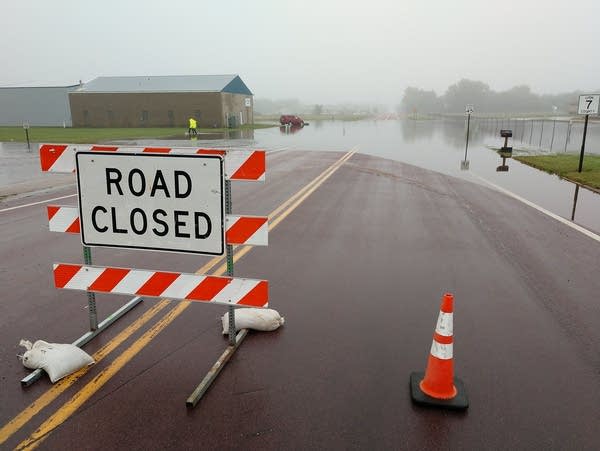Adding climate impacts to Minnesota's environmental review may be delayed

A yearslong effort to incorporate climate change impacts into Minnesota's environmental review process could face possible delays.
The changes would require proposers of new highways, industrial plants, livestock feedlots or large housing developments to calculate their project's carbon footprint, and consider how to reduce greenhouse gas emissions that contribute to climate change.
Climate activists say the changes are overdue. But there's been some pushback from business groups, farmers and local governments, who say they would be burdensome and would raise the cost of building projects.
The Minnesota Environmental Policy Act, passed into law nearly 50 years ago, created the state’s environmental review process. It requires regulators to consider a project’s potential impacts to land, air, water and wildlife.
Create a More Connected Minnesota
MPR News is your trusted resource for the news you need. With your support, MPR News brings accessible, courageous journalism and authentic conversation to everyone - free of paywalls and barriers. Your gift makes a difference.
Back then, climate change wasn’t on many people’s radar. The form used for most projects, known as an environmental assessment worksheet, or EAW, doesn’t include questions about climate change impacts.
Now, climate change is at the forefront of environmental concerns for many Minnesotans. The state set a goal to reduce greenhouse gas emissions 80 percent between 2005 and 2050, but currently is not on track to meet that goal.
In 2019, an interagency team started looking at incorporating climate change impacts into the state's environmental review process for new projects like industrial plants or large animal feedlots. About 100 projects go through the process every year.
Earlier this year, the Minnesota Environmental Quality Board, which oversees the review process, released its draft recommendations. They would require projects to calculate how much carbon dioxide, methane and other gases they would emit.
Large emitters would also have to discuss how they plan to reduce or mitigate those impacts — such as by putting solar panels on the roof, or using energy efficient lights.
Proposers also would have to consider how the impacts of climate change — such as heavier rainfalls or warmer temperatures — might affect their project, such as a highway prone to flooding.
Mixed response
The board asked for public input and received nearly 1,000 comments. It also held public input sessions and conducted a survey.
Many of the commenters were supportive. They said these changes are overdue and will provide important information to both the people designing these projects, and the local governments deciding whether to approve them.
But others voiced concern that the new requirements will be burdensome, and will increase the time and cost of new projects by tens of thousands of dollars.
"Businesses are still trying to recover from that COVID pandemic right now,” said Tony Kwilas, environmental policy director for the Minnesota Chamber of Commerce, at a recent subcommittee meeting. “The timing of the proposal right now for us is concerning. And we worry about placing more restrictions on businesses as we come out of COVID-19."
Critics also said local governments that oversee the majority of these environmental reviews often don't have the staff or expertise to analyze this information and know how to use it.
“This sounds like another unfunded mandate for counties that will require additional costly, highly technical staff to implement an undefined standard,” said Luke Johnson, a Pipestone County, Minn., commissioner.
More time needed?
This month, the board released final recommendations, which some environmental advocates say are weaker.
On one hand, they require all projects to calculate their greenhouse gas emissions regardless of size. But they only require the projects to analyze their chosen option to mitigate those impacts, instead of examining all possible alternatives.
It also appears that the changes could be delayed, or phased in as a pilot project over the next year or so.
Local governments would be able to voluntarily enroll, get assistance and provide feedback before the new EAW form becomes a requirement for all projects, said Denise Wilson, director of the Environmental Quality Board’s environmental review program.
But any further delays concern climate activists, who say the risk is too high while Minnesota is already dealing with the costly effects of climate change.
Amelia Vohs, a regulatory attorney with the Minnesota Center for Environmental Advocacy, said it makes more sense for the state to get its feet wet when it comes to calculating climate impacts, rather than wait any longer.
"We don't have more time for study,” Vohs told the subcommittee. “When you're in a hole, the first step to getting out of the hole is to stop digging. But every day that we're permitting projects without considering their climate effects, we're still picking up that shovel."
Next steps
The technical team working on the recommendations will bring them to the full Environmental Quality Board in September. The board will then decide whether to move forward and adopt the changes to the review process, delay them, or phase them in.
The Environmental Quality Board’s Wilson said she’s been encouraged by the strong interest in the process, and the large number of people who’ve weighed in.
“I think we did get a good robust set of information on exactly what we were looking for — the ways in which the recommendations might have unintended consequences, and whether or not the information that we were going to be asking for project proposers and government agencies to provide to the public would be meaningful,” she said.